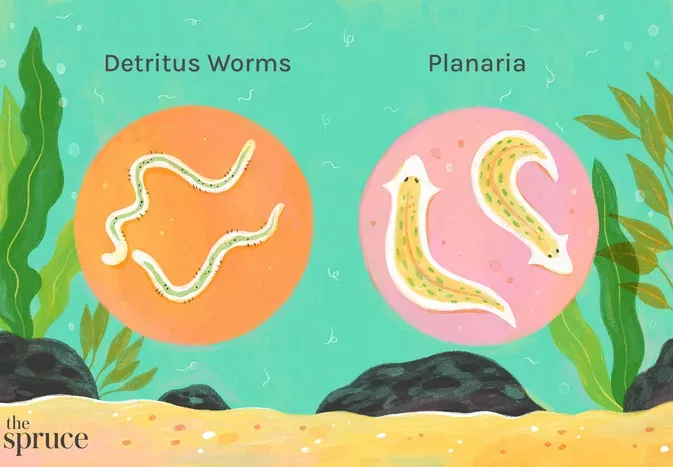What Are Those Tiny White Worms in My Fish Tank?
Updated on 04/26/24

What Are Those Tiny White Worms in My Fish Tank?
Tiny white worms in a fish tank can be a disconcerting sight for any aquarium owner. These unwelcome guests can range in size from barely visible to several millimeters in length, and their presence often raises concerns about the health of the tank's inhabitants. Understanding the nature of these worms is crucial for taking appropriate action to eliminate them and restore the well-being of your aquatic ecosystem.
Types of Tiny White Worms in Fish Tanks
Various types of small white worms can infest fish tanks, each with its unique characteristics:
- Planaria: Flatworms with triangular-shaped heads and elongated, flattened bodies. They glide smoothly through the water and are typically 2-25 mm in length.
- Detritus Worms: Slender, segmented worms that resemble tiny threads or hairs. They are usually 1-5 mm in length and scavenge on decaying organic matter.
- Rhabdocoela: Tiny, roundish worms with pointed heads and transparent bodies. They are generally less than 2 mm in length and feed on algae and microorganisms.
- Anchor Worms: Parasitic crustaceans that attach themselves to fish using hook-like structures. Their bodies are segmented and white in color, with females growing up to 10 mm in length.
- Copepods: Minute crustaceans that are often beneficial to fish tanks as they feed on algae and debris. However, some species can become parasitic and attach themselves to fish, causing irritation and damage.
Causes of Tiny White Worms in Fish Tanks
The appearance of tiny white worms in a fish tank can be attributed to several factors:
- Overfeeding: Excess food that remains uneaten can decompose and create a favorable environment for worms to thrive.
- Poor Filtration: Inefficient filtration systems can allow organic waste to accumulate, providing sustenance for worms.
- Live Food: Live foods, such as brine shrimp or bloodworms, may introduce worm eggs or larvae into the tank.
- Plants: Newly acquired plants can harbor worm eggs or cysts that hatch later on.
- New Fish: Fish purchased from infected tanks can carry worm infestations.
Impact of Tiny White Worms on Fish
The presence of small white worms in a fish tank can have varying effects on its inhabitants:
- Planaria: While generally harmless to fish, planaria can compete with them for food and may irritate their gills.
- Detritus Worms: Detritus worms are not typically harmful to fish but can become unsightly and contribute to poor water quality.
- Rhabdocoela: These worms can irritate fish and may cause minor skin damage.
- Anchor Worms: Anchor worms are parasitic and can cause significant discomfort and damage to fish. They attach themselves to the fish's skin, gills, or fins, leading to tissue damage, inflammation, and secondary infections.
- Copepods: Parasitic copepods can cause irritation, stress, and anemia in fish.
Prevention and Control of Tiny White Worms
Maintaining a clean and well-maintained aquarium is crucial for preventing and controlling worm infestations:
- Regular Cleaning: Perform regular gravel vacuuming and water changes to remove excess food and debris that attract worms.
- Proper Filtration: Invest in a high-quality filtration system that efficiently removes waste particles and maintains water clarity.
- Quarantine New Additions: Isolate new fish and plants for a period of time before introducing them to the main tank to prevent the spread of parasites or worms.
- Careful Feeding: Avoid overfeeding and remove uneaten food promptly to reduce the amount of organic matter available for worms to feed on.
- Medication: In cases of severe infestations, medication may be necessary to eliminate worms. Consult with a veterinarian or experienced aquarist for advice on appropriate treatment options.
Additional Tips for Eradicating Tiny White Worms
- Hydrogen Peroxide Treatment: Add 1 mL of 3% hydrogen peroxide per 10 gallons of tank water. Run the filter for 1 hour, then perform a 25% water change. Repeat as needed.
- Fenbendazole Treatment: Fenbendazole is an anthelmintic medication that can be effective against certain types of worms. Follow the dosage instructions carefully and consult with a veterinarian for guidance.
- Beneficial Bacteria: Adding beneficial bacteria to the tank can help to break down organic waste and create a less hospitable environment for worms.
- UV Sterilization: UV sterilizers can help to kill worm eggs and larvae, but they should be used with caution as they can also harm beneficial bacteria.
Remember, maintaining a clean and healthy aquarium environment is the best way to prevent and control worm infestations. Regular maintenance, proper feeding practices, and prompt action can help to keep your fish tank free of these unwanted guests.
Explore More Pets

Freshwater Aquarium Filters
How to Deal With Cloudy Aquarium Water

Saltwater Aquarium Filters
How Do You Remove Chloramines From Tap Water?

Freshwater Aquariums & Habitat
Can I Keep My Koi Fish Inside?

Saltwater Aquariums & Habitat
14 Best Floating Plants for Your Aquarium

Freshwater Fish Health
How to Treat Ich on Freshwater Fish

Saltwater Fish Health
Fin Rot in Aquarium Fish

Freshwater Aquarium Filters
How to Do Aquarium Water Changes

Saltwater Fish Health
How Do Fish Get Parasites?